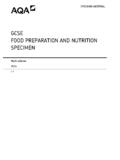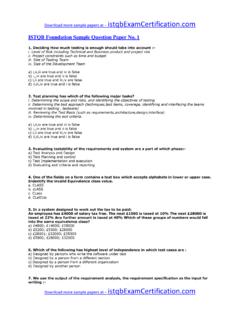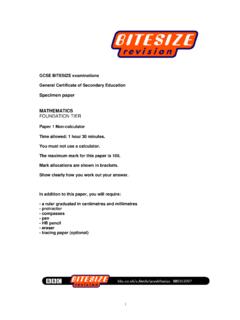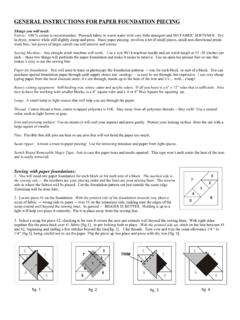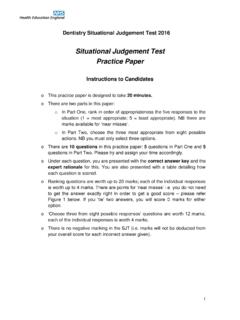Transcription of Foundation Tier Paper 3: Chemistry 1F - …
1 SPECIMEN MATERIAL GCSE COMBINED SCIENCE: TRILOGY Foundation Tier Paper 3: Chemistry 1F Specimen 2018 Time allowed: 1 hour 15 minutes Materials For this Paper you must have: a ruler a calculator the periodic table (enclosed) Instructions Answer all questions in the spaces provided. Do all rough work in this book. Cross through any work you do not want to be marked. Information There are 70 marks available on this Paper . The marks for questions are shown in brackets. You are expected to use a calculator where appropriate. You are reminded of the need for good English and clear presentation in your answers. When answering questions , and 05 you need to make sure that your answer: is clear, logical, sensibly structured fully meets the requirements of the question shows that each separate point or step supports the overall answer. Advice In all calculations, show clearly how you work out your answer.
2 Please write clearly, in block capitals. Centre number Candidate number Surname Forename(s) Candidate signature F 2 SPECIMEN MATERIAL There are no questions on this page 3 SPECIMEN MATERIAL Turn over 0 1 The pH scale is a measure of the acidity or alkalinity of a solution. 0 1 . 1 Draw one line from each solution to the pH value of the solution. [2 marks] 0 1 . 2 Which ion in aqueous solution causes acidity? [1 mark] Tick one box. H+ Na+ O2 OH Question 1 continues on the next page 4 SPECIMEN MATERIAL When sulfuric acid is added to sodium hydroxide a reaction occurs to produce two products. The equation is: H2SO4 + 2 NaOH Na2SO4 + 2H2O 0 1 . 3 How many elements are in the formula H2SO4? [1 mark] Tick one box. 3 4 6 7 0 1.
3 4 What is this type of reaction? [1 mark] Tick one box. Decomposition Displacement Neutralisation Reduction 0 1 . 5 Name the salt produced. [1 mark] 5 SPECIMEN MATERIAL Turn over 0 1 . 6 Describe how an indicator can be used to show when all the sodium hydroxide has reacted with sulfuric acid. [3 marks] Turn over for the next question 6 SPECIMEN MATERIAL 0 2 John Newlands arranged the known elements into a table in order of atomic weight. Figure 1 shows part of Newlands table. Figure 1 0 2 . 1 What are the names of the elements in Group 5 of Newlands table? [1 mark] Tick one box. Calcium and sulfur Carbon and silicon Chlorine and silver Chromium and tin 7 SPECIMEN MATERIAL Turn over 0 2.
4 2 In what order is the modern periodic table arranged? [1 mark] Tick one box. Atomic mass Atomic number Atomic size Atomic weight 0 2 . 3 Give two differences between Group 1 of Newlands table and Group 1 of the periodic table. [2 marks] Question 2 continues on the next page 8 SPECIMEN MATERIAL 0 2 . 4 In 1864, atoms were thought to be particles that could not be divided up into smaller particles. By 1898, the electron had been discovered and the plum pudding model of an atom was proposed. Figure 2 shows the plum pudding model of an atom of carbon and the nuclear model of an atom of carbon. Figure 2 Compare the position of the subatomic particles in the plum pudding model with the nuclear model. [4 marks] 9 SPECIMEN MATERIAL Turn over 0 2 . 5 Models are used to show the differences between elements, compounds and mixtures.
5 Which circle shows a model of a mixture? [1 mark] Tick one box. Question 2 continues on the next page 10 SPECIMEN MATERIAL Figure 3 shows a model of carbon dioxide. Figure 3 0 2 . 6 What does each line between the atoms in Figure 3 represent? [1 mark] Tick one box. Covalent bond Intermolecular force Ionic bond Metallic bond 11 SPECIMEN MATERIAL Turn over 0 3 Some students investigated the reactivity of four unknown metals, W, X, Y and Z. The letters are not the symbols of these elements. The students used metal salt solutions of copper nitrate, magnesium sulfate and zinc chloride. This is the method used. 1. Pour a solution of a metal salt into a glass beaker. 2. Measure the temperature of the solution. 3. Add 1 g of metal to the solution. 4. Measure the temperature of the solution.
6 5. Calculate the temperature increase. The students did the experiment using each salt solution with each metal. Figure 4 shows the apparatus the students used. Figure 4 Question 3 continues on the next page 12 SPECIMEN MATERIAL Table 1 shows the students results. Table 1 Temperature increase in oC Solution Metal W Metal X Metal Y Metal Z Copper nitrate 46 10 29 No change Magnesium sulfate No change No change No change No change Zinc chloride 15 No change No change No change 0 3 . 1 Which metal is least reactive? [1 mark] Tick one box. Metal W Metal X Metal Y Metal Z 0 3 . 2 How do the results show that magnesium is more reactive than the metals W, X, Y and Z? [1 mark] 13 SPECIMEN MATERIAL Turn over 0 3 . 3 How do the results show that the reaction between metal Y and copper nitrate solution is exothermic?
7 [1 mark] 0 3 . 4 One student said that the investigation was not valid (a fair test). Write a plan for the investigation that includes improvements to the method and apparatus. [4 marks] Question 3 continues on the next page 14 SPECIMEN MATERIAL Figure 5 shows the reaction profile of an exothermic reaction. Figure 5 0 3 . 5 What does the energy value of 1370 kJ represent? [1 mark] Tick one box. Activation energy Products energy Reactants energy Released energy 0 3 . 6 The overall energy change is 386 kJ. What percentage of 1370 kJ is this? Give your answer to two significant figures. [2 marks] Percentage = % 15 SPECIMEN MATERIAL Turn over Turn over for the next question 16 SPECIMEN MATERIAL 0 4 The three states of matter are solid, liquid and gas.
8 0 4 . 1 Lithium reacts with water to produce lithium hydroxide solution and hydrogen. Use the correct state symbols from the box to complete the chemical equation. [2 marks] aq g l s 2Li(s) + 2H2O(l) 2 LiOH(..) + H2(..) lithium + water lithium hydroxide + hydrogen Figure 6 shows the melting points and the boiling points of four substances, A, B, C and D. Figure 6 17 SPECIMEN MATERIAL Turn over 0 4 . 2 Which substance is liquid over the greatest temperature range? [1 mark] Tick one box. A B C D 0 4 . 3 Which two substances are gases at 50 C? [1 mark] Tick one box. A and B B and C C and D A and D 0 4 . 4 A different substance, E, has: a melting point of -50 oC a boiling point of +120 oC Plot these two values on Figure 6.
9 [2 marks] Question 4 continues on the next page 18 SPECIMEN MATERIAL Figure 7 shows the apparatus a student used to determine the melting point and the boiling point of substance B in Figure 6. Figure 7 0 4 . 5 Explain why the student could not use this apparatus to determine the boiling point of substance B. [2 marks] 0 4 . 6 Suggest one reason why the student could not use this apparatus to determine the exact melting point of substance B. [1 mark] 19 SPECIMEN MATERIAL Turn over Turn over for the next question 20 SPECIMEN MATERIAL 0 5 This question is about making copper salts. Figure 8 shows the apparatus given to a student. Figure 8 21 SPECIMEN MATERIAL Turn over Outline a safe plan the student could use to make pure, dry, crystals of the soluble salt copper sulfate from the insoluble metal oxide and dilute acid.
10 [6 marks] Turn over for the next question 22 SPECIMEN MATERIAL 0 6 Figure 9 shows an apparatus to produce elements from a solution of an ionic compound. Figure 9 0 6 . 1 What is the name of the process in Figure 9? [1 mark] Tick one box. Combustion Crystallisation Distillation Electrolysis 23 SPECIMEN MATERIAL Turn over [2 marks] At cathode At anode [2 marks] Table 2 shows the products formed from three experiments using different compounds and the apparatus shown in Figure 9. Table 2 Compound State Product at cathode Product at anode Copper chloride Molten Copper Chlorine Copper chloride Aqueous solution Copper Chlorine Potassium bromide Molten Potassium Bromine 0 6 . 2 Use Table 2 to name the products formed at each electrode if using an aqueous solution of potassium bromide.









